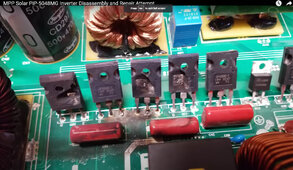DIYrich
Solar Wizard
Battery powering screen is ok (low voltage). Pv powering screen means the connection from high voltage to low voltage is working. Maybe the high voltage bus to inverter is faulting. Lots of capacitors there, so not diy friendly repair.I believe I tried that, I think it still turned on the screen but kept the Inverter board off. Which is weird since it means it is capable of pulling power from battery atleast enough to power itself. I think even PV only had the screen working but staying off otherwise



